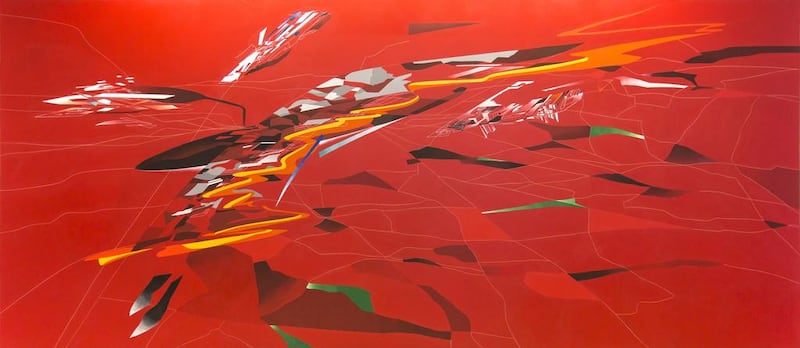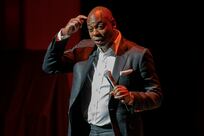The paintings and drawings of award-winning architect Zaha Hadid show where the ideas for her buildings came from. A gallery she designed pays tribute to the late artist with an exhibition of her earlier work.
Taking pride of place on a wall of the exhibition space she redesigned, there’s something familiar about Metropolis, the 1988 painting by architect Zaha Hadid, at the Serpentine Sackler Gallery, London.
The way the fluid shapes seem to hover above the surface.
"These paintings are such an insight into her architecture," says Amira Gad, curator of Zaha Hadid: Early Paintings and Drawings. "They show where it all started for her."
Twenty-five years after she painted Metropolis, Zaha Hadid Architects won a competition to build environment and waste management company Bee’ah’s new headquarters in Sharjah.
Its sweeping curves and globular structures are an echo of this intriguing artwork that was created long before the Iraq-born British architect truly made her name.
The exhibition celebrates Hadid the artist rather the visionary architect – there are no photographs of her famous public buildings such as London 2012’s Aquatics Centre or Galaxy Soho, Beijing.
But it goes without saying that for Hadid, the two disciplines were inextricably linked.
The show focuses on her early works before her first structure was built (the Vitra Fire Station in Germany in 1993) and there is a thematic connection between these sketches, drawings and paintings taken from the period between 1976 and 1992 and the architecture that would follow.
Even, perhaps, a signature style.
“You can see her formulating her ideas about architecture in the art she was making,” says Gad. “There are a few pillars to understanding her work. She often spoke about curved lines – you can see them in these drawings and sketches, and then walk out and experience them in the design of the Magazine Restaurant in this gallery, which she designed in 2013.
“Then she had this idea of a building having a feeling of weightlessness, of defying gravity and spatial considerations, and you can really appreciate that in her paintings.”
In fact, what the exhibition underlines is that Hadid’s architecture had as much of a basis in outlandish artistic ideas as computer-aided structural design.
Perhaps that is why Hadid, unfortunately, became as well known for projects that did not come to fruition.
Undeniably, the Dubai Financial Market, envisioned in 2007 as a series of petals floating on Business Bay underneath “dancing towers”, was beautiful but, in the midst of the financial crash, impractical and dizzyingly expensive. It remains a design.
Meanwhile, for all its incredible sculptural forms that seem to emerge organically from the water onto Sadiyaat Island, next year will mark a decade since Hadid designed the Abu Dhabi Performing Arts Centre and building work has still not begun.
If it seems disrespectful to talk of Hadid’s failures in the year of her death, there was always a side to her that was defiant and uninhibited despite the labels she laboured under, namely that it was too difficult to complete one of her award-winning designs.
No matter, she would just turn her attention to something else until somebody found enough money to build it properly.
When Hadid founded Zaha Hadid Architects in 1979, she quickly forged a reputation for ground-breaking theoretical works rather than finished buildings. Viewers can appreciate the theory in paintings such as Vision For Madrid, Spain (1992), if not the practice.
Still, Abu Dhabi can at least boast one of her very best completed structures, 2010’s Sheikh Zayed Bridge. Its swooping arches and curves soar over the Maqtah Channel in magical evocations of nearby sand dunes. They are a reminder of her Metropolis painting.
“For her, painting was a design tool, a thought process, an investigation, and she used that medium to formulate her ideas,” says Gad, who points out that Hadid was passionate about Russian avant garde artist Kazimir Malevich simply because of the way he was able to combine art and design so successfully.
“Actually, some of these paintings are architectural design proposals,” she says. “But instead of exact computer aided designs, she’s leaving room for the imagination of the viewer, she’s engaging directly with them. That’s a really interesting concept.”
The sadness, of course, is that Hadid cannot explain her motivations when the exhibition opens this week.
Gad says it was Hadid’s dream to have her artworks presented inside the Serpentine Sackler Gallery, a building both the architect and the gallery regard as their own.
The curator found 10-year-old conversations between Hadid and the Serpentine’s director Hans Ulrich Obrist about a potential exhibition of her notebook drawings and early paintings, and the idea was back on the agenda after Hadid became the first woman to win the RIBA gold medal in February, a month before she died, age 65.
Obrist promised that her declaration “there should be no end to experimentation” will now be a mantra for the Serpentine Gallery as it looks to the future without its famous trustee and supporter.
Quite a legacy – and for once that is not an over-exaggerated claim for a highly regarded public figure.
In Dubai, her mixed-use Opus building will open next year after many years of delays, its void in the middle mirrored in a concept painting in the exhibition for one of her most talked about projects, Cardiff Bay Opera House.
The Bee’ah HQ should see the light of day soon, too, an environmentally friendly, low-impact conurbation of intersecting “dunes” in Sharjah.
Regionally, Qatar hopes to have a tower Hadid shaped like a desert flower ready for the 2022 World Cup final, while the King Abdullah Petroleum Studies and Research Centre in Riyadh was officially opened earlier this year.
Elsewhere in Saudi Arabia, a geometric, lattice-like structure rises above Riyadh’s Financial District Metro Station, and a planned Urban Heritage Administration Centre in Diriyah refers to the challenges and pleasures of the natural world.
So Hadid’s death certainly does not mean the end for her company – far from it.
Last month it opened an office in Dubai and it will be fascinating to see how Zaha Hadid Architects in Dubai Design District develops and whether it pays tribute to Hadid’s unique style or goes off in new directions.
Without its star so willing to deflect criticism through unbending belief in her visionary approach, it is possible that Zaha Hadid Architects might end up proposing slightly more sober and achievable designs.
For now, the idea is to collaborate with visionary clients across the region on 16 projects.
There is also a Harvard architecture scholarship programme together with Dubai property developer Omniyat to offer financial aid to architecture students from the Middle East.
Such impressive global plans from a practice with billions of dollars of projects and more than 400 staff might seem a long way from decades-old paintings, which often explore Hadid’s utopian ideals, but that is the key to understanding Hadid’s work.
She may not always have seen her avant-garde designs through to fruition as finished structures but Hadid always tried to push the boundaries of what 21st century architecture might mean or achieve.
And every so often she succeeded in getting clients to not just believe in her ideals, but to pay for them, too.
As she told the Financial Times, it is not what a building is made of that is important, but what it does.
“Good space transcends taste and values,” she said.
“It’s a weird, mystical thing. It’s very difficult to achieve, but you know when you’ve got it.”
The weird and mystical are certainly brought to bear in this new exhibition. So what does its curator hope it achieves, now that its subject has passed away?
“The point with this exhibition is to celebrate Zaha’s paintings,” says Gad. “And we really do want to emphasise the power and authority the paintings have as art works rather than as case studies for future buildings.
“But there will always be her architecture, which you can go and live and breathe and explore physically.
“In both these paintings and her buildings you can really appreciate her imagination and the way she engaged with the world. She was a remarkable woman.”
Zaha Hadid: Early Paintings and Drawings opens on Thursday at the Serpentine Sackler Gallery, London, until February 12. Log on to serpentinegalleries.org.
newsdesk@thenational.ae






